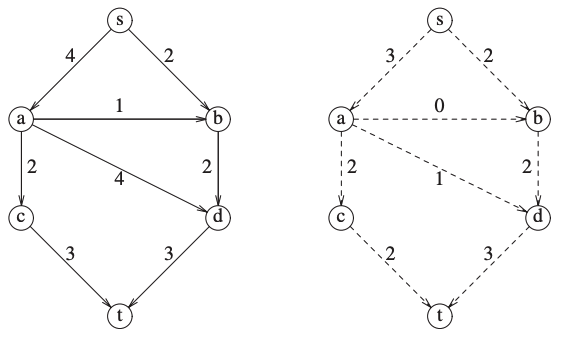15. Network Flow Problems
Suppose a directed graph \(G=(V,E)\).
Each edge has a capacity of \(c_{v,w}\).
We could consider that the capacity is the amount of water that could flow through a pipe.
Definition
In a network flow problem, the graph contains two nodes:
\(s\) called the source.
\(t\) called the sink.
\(c_{v,w}\) is the maximum unit of “flow” that can pass.
At any vertex \(v\) (not being \(s\) or \(t\)) the total incoming flow must be equal to the total flow exiting the node.
The maximum flow problem is to determine the maximum flow amount that can pass from \(s\) to \(t\).
The following graph has a maximum flow of 5:

Activity
Do you have any real application of this problem?
Can you increase the flow in this graph?
Can you prove it?
If we cut the graph in two parts:
A part containing \(s\) and few nodes.
A part containing \(t\) and few nodes.
The capacity leaving the first part is the maximum flow:

15.1. A simple Maximum-Flow algorithm
We start with our graph \(G\) and construct a flow graph \(G_f\).
\(G_f\) is the flow that has been attained at any stage.
Initially all edges in \(G_f\) has no flow.
At the end \(G_f\) should contain the maximum flow.
We also construct \(G_r\), the residual graph.
\(G_r\) contains for each edge how much flow can be added.
How does it work?
At each stage, we find a path in \(G_r\) from \(s\) to \(t\).
The minimum edge on the path is the amount of flow that is added to every edge on the path in \(G_f\).
We recalculate \(G_r\) and we add an opposite edge with the same capacity.
When we find no path from \(s\) to \(t\) in \(G_r\) we stop.
Example
If we apply it to the previous graph.

Now we find a path:

And we continue:

You can see that we changed a previous flow.